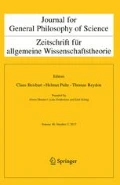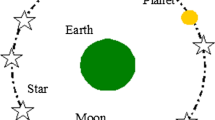“The conservation of health has always been the principal goal of my studies”.
Descartes
Summary
We shall proceed as follows: In section ii, we shall give a brief over-view of the literature on Gilbert, more to indicate general directions of interest than to present any in-depth analysis. Then, in the main body of this presentation, section iii, we will present three ways in which we think it is accurate to claim that Gilbert influenced Descartes. These are: (1) Gilbert gave Descartes a new definition of an organ; (2) Gilbert gave Descartes a new definition of what constitutes life and animation; (3) Gilbert gave Descartes a new view of natural motion.
Similar content being viewed by others
References
Walter Langdon-Brown, “William Gilbert: His Place in the Medical World”,Nature 154 (7/1944) pp. 136–139.
Ibid., p. 39.
Jane M. Oppenheimer, “William Gilbert on Plant Grafting”,Journal of the History of Medicine 8 (1953), pp. 165–176.
Ibid., p. 175.
Ibid., p. 175.
Rufus Suter, “Dr. William Gilbert of Colchester”,Science 70 (1950), pp. 254–261.
Ibid., p. 258, 260.
Ibid., p. 259.
William Dampier,A History of Science Cambridge; 4th ed., 1968). “Gilbert states that, for a uniform lodestone, the strength and range of its magnetism is proportional to its quantity or mass. This seems to be the first realization of mass without reference to weight, and may have given the idea of mass to Kepler and Galileo, and through them to Newton”. (pp. 124–125) Dampier thus clearly sees the enormous contribution of Gilbert, but not the stature of the contributor!
Loc. cit., p. 260.
This use of the expression, “Neo-platonic mystic” is no more precise than the term “bourgeois”. The pre-eminent Gilbert scholar, Sylvanus P. Thompson, says ofDe Magnete: “Book 5 closes with an eloquent passage in which Gilbert affirmed the neo-Platonic doctrine of the animate nature of the universe, and asserted that Thales was right when he held (as Aristotle does in theDe Anima) that the lodestone was animate, being part of and indeed the choice offspring of its animate mother the earth”. (In hisWilliam Gilbert and Terrestrial Magnetism in the time of Queen Elizabeth, Cheswick Press, private printing, N.D.). However, Thales was no neo-Platonic, nor was Aristotle. The question of Gilbert's so-called neo-Platonism certainly invites further speculation and research.
Charles Singer, “Dr. William Gilbert (1594–1603)”,Journal of the Royal Naval Medical Service, (Oct. 1916, 16 pp.). Singer tells us that this piece is largely an abstract of a more extensive work by Sylvanus P. Thompson, thedoyen of Gilbert scholars.
Ibid., p. 498.
Ibid., p. 499.
Loc. cit., p. 499.
William Hale-White,Bacon, Gilbert, and Harvey (London; Bale, Sons & Danielson, 1927) p. 39.
Ibid., p. 11.
Ibid., pp. 45–46.
The article by Singer cited above tells us, p. 499, that it is possible that Gilbert worked with the great anatomist, Fabricius of Aquapendente, and thus, at the very least, had a deep and keen grasp and appreciation of anatomy.
Jean Pelseneer, “Gilbert, Bacon, Kepler, Harvey, et Descartes: leurs relations”,Isis 17 (1932), pp. 171–208.
Ibid., pp. 179–180.
Aristotle,De Anima, 414a, 28.
Ibid., 412a 28.
Ibid., 415b 18.
Ibid., 416b 4.
Compare: Descartes,The Description of the Human Body, (A. et T., XI, 25611ff.) withPrinciples of Philosophy, Part II, arts. 46–51, and Part III, arts. 133–138.
Galileo,Dialogue Concerning the Two Chief World Systems translated by Stillman Drake (University of California Press, 1953). See especially pp. 410–414,passim, and also p. 272. For Gilbert, see p. 239–240 ofDe Magnete.
See Aristotle'sPhysics, Book IV, (208a 27–213a 13), for his discussion of place and its relation to motion. In a complex way, the notion of place crops up in modern, post-1600, thought in the notion of mathematical ‘origin’. It might be objected to this that the notion of origin is absolutely relative and thus it can be used to overturn the notion of place as understood by Aristotle. But this misses the point: in order to be absolutely relative, origin has to carry place with it; otherwise, it would make no sense whatsoever. Indeed, it is not too bold to say that to hypothesize freely, without any restrictions from tradition or from some Orthodoxy, means precisely to be free to choose, arbitrarily, one intellectual origin and make that one's absolute, own, beginning of thinking: “Archimède, pour tirer le globe terrestre de sa place et le transporter en une autre lieu, ne demandait rien qu'un point qui fût fixe et assuré. Ainsi j'aurai droit de concevoir de hautes espérances, si je suis assez heureux pour trouver seulement une chose qui soit certaine et indubitable”. (Descartes, “Meditation Seconde”).
Author information
Authors and Affiliations
Rights and permissions
About this article
Cite this article
Carter, R.B. Gilbert and Descartes: The science of conserving the compound body. Zeitschrift für Allgemeine Wissenschaftstheorie 13, 224–233 (1982). https://doi.org/10.1007/BF01801557
Issue Date:
DOI: https://doi.org/10.1007/BF01801557




